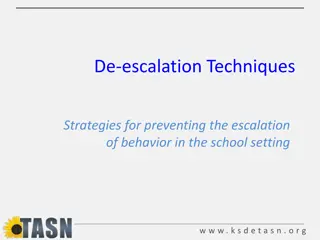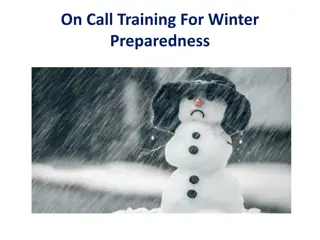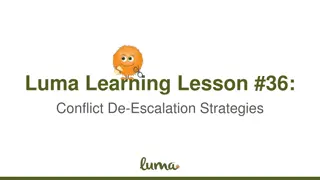Effective De-escalation and Distraction Techniques for Children
De-escalation techniques focus on helping children manage overwhelming emotions. Strategies include acknowledging feelings, using distraction, and giving space. Avoid demanding, stay calm, respect personal space, and offer distractions. Knowing what your child likes and dislikes is key to effective de-escalation. By providing support tailored to their needs, you can help children calm down in challenging situations.
Download Presentation

Please find below an Image/Link to download the presentation.
The content on the website is provided AS IS for your information and personal use only. It may not be sold, licensed, or shared on other websites without obtaining consent from the author. Download presentation by click this link. If you encounter any issues during the download, it is possible that the publisher has removed the file from their server.
E N D
Presentation Transcript
Techniques to support De-escalation and Distraction
What is de-escalation? Our children can often become emotionally or sensory overwhelmed or irritated in a situation which can lead to them expressing their emotions in a violent or aggressive way. De-escalation focuses on supporting and helping a person return their emotions and needs back down to their normal state.
How can we help? When trying to de-escalate a situation there are several things we can do: 1. Do not put a demand on the child 2. Use a calm voice when talking to them 3. Do not try to reason with them 4. Ignore verbal comments 5. Respect the child s personal space 6. Acknowledge their feelings 7. Use a distraction
Strategy 1- Acknowledging feelings Acknowledging your child s feelings is important when trying to bring them back down. Using the ZOR is a good tool to use and puts less pressure on the child to express their emotions as they can simply point to the symbol instead of talking. You can then use this to find out why they are feeling that way or what happened to make them feel that way. If the child refuses to talk about their feelings, that is ok. Do not pressure them into telling you how they are feeling. Just tell them you will wait until they are ready.
Strategy 2- Distraction Creating a distraction is one of the best things you can try when trying to de-escalate a situation. Knowing the child is really important here as you will need to know what things they like, enjoy doing etc. It s also important you know the things they don t like because if you try to distract them with something they don t like you will push them further into crisis mode. Making a special bag or box with the child. This special bag or box can contain a variety of things that make them happy or feel calm and will help their sensory needs. For example: bubbles, a squishy toy, a fiddle toy, pot of slime, pack of crackers, symbols, zones of regulation, colouring book and pencils, something noisy etc. You could also distract them by trying to engage them in their favourite activity for example: dancing, cooking, running outside, making an obstacle course, breathing exercises, playing with a pet, making playdough or slime etc.
Strategy 3- Giving space and silence Sometimes when a child is emotionally overwhelmed the best thing you can do is give them space and silence. Knowing your child, being able to read their mood and how safe they are in this situation will inform whether this is the best action to take. Giving a child some space to calm down on their own and time without and adult asking them if they are okay and just being around them can work well, as they can use their own self-regulation techniques and the distractions you have given them to support them to calm. It allows them to feel less under pressure of talking about how they are feeling or being aggravated by something someone says. When giving a child some space to calm down it is important that you do not full walk away. You need to be somewhere you can still see the child to ensure they are kept safe and also allows them to gradually come to you when they are feeling ready for comfort and to talk.

 undefined
undefined


























